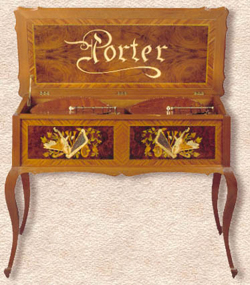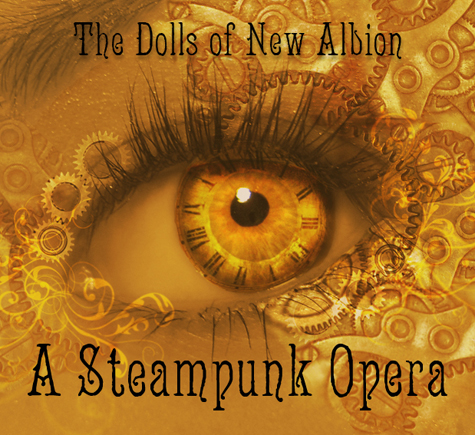After a year and a half of constant obsession, living part of each day in an internal fantasy land, hundreds of hours of music studio work, thousands of little musical notes played, dozens of pages of scribbled notes and lyrics, and approximately 14,000 cups of coffee, I have written and recorded a 4-act steampunk opera called The Dolls of New Albion, A Steampunk Opera. It’s a sci-fi musical set in the fantastical city of New Albion and follows four generations of a family whose interactions with the dead cause chaos in the city. The album completed, the first staged presentation fast approaches.
How exactly does one write a steampunk musical?
I think writing and composing a steampunk musical (without any spoken bits, so technically it’s an opera) is essentially like crafting a three-tiered jigsaw puzzle. The top layer of this puzzle is your story. The bottom layer is the music. The middle layer is where music and story meet, the division of the story into songs. You plug little ideas and solutions into the myriad of holes in each tier until it’s complete.
The Story Tier: Coming up with a story is essentially the same as I imagine it would be for someone writing a book or film script. Personally, I always start with an image in my head and extrapolate from it until I have a story. In this case the image was a mad scientist in her laboratory with a steampunk manikin. Once I realized she was going to put the soul of her dead love into it, the story poured forth, and from there I built a world around it.
Because science fiction and fantasy deal with made-up worlds, a lot of creativity can go into building the world in which the story takes place. A literary author can go into enormous detail, but for a musical opera, no matter how much background work I do, the only text I have to work with is what will be sung by the characters, so the amount of information about my world that I can communicate is very limited. I got around this to a certain extent by having a Narrator open the show, describing my steampunk city and its denizens.
Staging and sets will help fill in the world a little more. In film, you can use CGI to create all sorts of wonders, but in theater, with the reality of budgets and staging being what they are, you need to sacrifice spectacle for the suggestion of spectacle. Theater, using lights, sets and costumes does not accurately reproduce an environment, it suggests it. You cannot depict the Battle of Helm’s Deep but you can depict an orc in the midst of it singing about it.
A show uses scenes and Acts to organize the story. The day after deciding to write the steampunk opera, I was browsing a bookstore and stumbled across a book about Escher loops. The back cover mentioned using Escher loops in ways outside of painting. I thought this was a fascinating concept and decided to try to do this with the plot for the opera. Just like an Escher castle has four staircases which feed into each other, I would have four Acts that served the same function. Each Act would tell its own separate story, but each story would feed into the other and create a loop. This is how the idea of the story taking place in four successive generations came about.
The Music Tier: What should steampunk music sound like? Here I had an advantage in that there is still no established musical genre, so I was free to define from scratch what steampunk music means to me. Even better, since it’s a futuristic past, I could combine any aspects of Victorian and modern music and use whatever cockamamie rationale I wanted to explain how, in my world, they invented the back beat in 1883.

I spent time online scouring Victorian music tropes, which gave me a flurry of ideas. For instance, I discovered an amazing Victorian music box. The moment I heard it I knew it had to be the sound that opened the entire show.
I became enamored with the Victorian music hall scene and the birth of cabaret. Thus I built what amounts to a music hall rock band with steampunk instruments: piano, drums, accordion, tuba and bass with some ambient F/X and industrial percussion behind everything. To me, at least, that was the sound of steampunk.
Structure and mood are the only aspects of a song I know before I sit down in my studio. The sound, instrumentation, and most of the melodies happen as I go. I load up an instrument or two onto my computer and start playing and recording them on a digital piano. A few notes of a certain sound will suggest some more notes from another type of sound, and it goes from there. Many of my songs begin with a short spacey intro, which was me feeling out the sound of the song.
Lastly, we come to the Middle Tier, where I look at my story and divide it up into songs. This part is enormous fun; however, with an opera, it calls for a slightly illogical approach. A book or film will center on the moments of action. In a musical, the action is of secondary importance and the important moments are those before and after the action. Characters singing about what they’re currently doing come off ridiculously. Opening a can of worms singing “I’m opening this can of worms, tra la la!” as they do it sounds silly. They sing about the excitement or trepidation they feel before they open it or the pain or exaltation after it’s opened.
For example, one of the most popular songs on the album is “Annabelle’s Lament” in Act 1, where the scientist Annabelle realizes she’s made a mistake in bringing back her dead love and destroys him. The destruction of the steampunk manikin takes place during the last 15 seconds of the song and is nothing next to the preceding five minutes where she laments over her profound loneliness and the roots of it dating back to her childhood and her almost Objectivist-oriented parents. Professionally and personally she had put so much hope into the resurrected steampunk manikin and now must face that it has all been misguided. The “action” is the last 15 seconds, but by the time it comes, it is incidental to the emotion released preceding it.
Musical opera is all about a character’s emotional state. Songs and music are emotional first and foremost. The opening of the worm can takes a few seconds, but the song about how it makes the character feel can last for minutes and can drive the audience to an outpouring of passion in a way even a film or book cannot.
Plot by plot, song by song, note by note the three layer puzzle gets built. After the puzzle is built, the piece written and recorded, the list goes ever on. Aside from the work that needs now to be done with live performers, there’s funding, designers, producers, staging, lights…. But fortunately, I needn’t worry about all that now. That, thank heaven, is why they invented directors.
Paul Shapera is a musician who loves to tell stories in music form and thinks he would have made a wonderful bard. You can listen to The Dolls of New Albion, A Steampunk Opera here. His blog about all subjects and tangents related to A Steampunk Opera is here.










